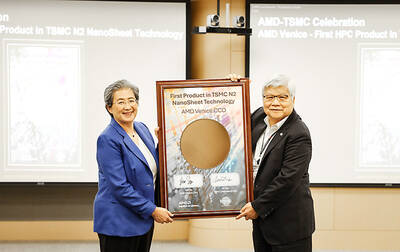E Ink Holdings Inc (元太科技), the world’s biggest e-paper display supplier, is bracing for a headwind in the first half of this year due to dwindling demand and excessive stockpiles, it said yesterday.
E-paper displays for e-readers and new e-notebooks constituted 70 percent of E Ink’s overall revenue last year, totaling NT$15.2 billion (US$521.58 million).
“We expect the e-reader segment to weaken amid a slack season. Moreover, clients are transitioning to new models, which is digesting inventories,” company chairman Frank Ko (柯富仁) told an investor teleconference. “We are conservative about the outlook for shipment figures of e-paper displays for e-readers.”
Ko forecast that e-notebooks and electronic shelf labels would be the bright spots, with e-paper displays for those two categories showing annual growth in the first two quarters of this year as customers launch more products to take advantage of an uptake of those applications.
E-paper displays used in electronic shelf labels made up about 17 percent of the company’s total revenue last year, E Ink said.
Chinese retailers — such as a new supermarket funded by Alibaba Group Holding Ltd (阿里巴巴) — last year joined their peers in the US and Europe in adopting electronic shelf labels, the company said.
E-paper displays for e-notebooks are to grow substantially this year given last year’s lower comparison base, it said, adding that the company began supplying e-paper displays for clients in the third quarter of last year and expects to increase shipments this year.
To cope with growing customer demand, E Ink said it plans to increase its capital spending this year, compared with NT$440 million last year.
Royalty income is to remain stable at an average of NT$2.4 billion this year, from NT$2.6 billion last year, it said.
Gross margin is to hold steady or drop slightly in the first six months of this year, compared with 39.5 percent for the same period last year, Ko said, adding that the decline could be attributed the a strong New Taiwan dollar, higher raw material costs and unfavorable product portfolios.
E Ink registered 42.1 percent gross margin for the final quarter of last year, bringing it to 42.88 percent in the second half of last year.
The company posted a loss of NT$50 million in the fourth quarter of last year, from a profit of NT$1.17 billion in the previous quarter and a profit of NT$891 million for the previous year.
E Ink said a foreign-exchange loss of NT$461 million and a loss of NT$516 million from bankrupted Hydis Technologies Co were behind the weak earnings.
E Ink no longer needs to book any losses from the South Korean subsidiary as it has settled lawsuits with the labor union at Hydis and has disposed of all the firm’s equipment and facilities, it said.
For the whole of last year, E Ink saw net profit increase 8.9 percent to NT$2.08 billion, from NT$1.91 billion the previous year. Earnings per share rose from NT$1.69 to NT$1.85 and foreign-exchange losses swelled to NT$671 million.

TAKING STOCK: A Taiwanese cookware firm in Vietnam urged customers to assess inventory or place orders early so shipments can reach the US while tariffs are paused Taiwanese businesses in Vietnam are exploring alternatives after the White House imposed a 46 percent import duty on Vietnamese goods, following US President Donald Trump’s announcement of “reciprocal” tariffs on the US’ trading partners. Lo Shih-liang (羅世良), chairman of Brico Industry Co (裕茂工業), a Taiwanese company that manufactures cast iron cookware and stove components in Vietnam, said that more than 40 percent of his business was tied to the US market, describing the constant US policy shifts as an emotional roller coaster. “I work during the day and stay up all night watching the news. I’ve been following US news until 3am

UNCERTAINTY: Innolux activated a stringent supply chain management mechanism, as it did during the COVID-19 pandemic, to ensure optimal inventory levels for customers Flat-panel display makers AUO Corp (友達) and Innolux Corp (群創) yesterday said that about 12 to 20 percent of their display business is at risk of potential US tariffs and that they would relocate production or shipment destinations to mitigate the levies’ effects. US tariffs would have a direct impact of US$200 million on AUO’s revenue, company chairman Paul Peng (彭雙浪) told reporters on the sidelines of the Touch Taiwan trade show in Taipei yesterday. That would make up about 12 percent of the company’s overall revenue. To cope with the tariff uncertainty, AUO plans to allocate its production to manufacturing facilities in

COLLABORATION: Given Taiwan’s key position in global supply chains, the US firm is discussing strategies with local partners and clients to deal with global uncertainties Advanced Micro Devices Inc (AMD) yesterday said it is meeting with local ecosystem partners, including Taiwan Semiconductor Manufacturing Co (TSMC, 台積電), to discuss strategies, including long-term manufacturing, to navigate uncertainties such as US tariffs, as Taiwan occupies an important position in global supply chains. AMD chief executive officer Lisa Su (蘇姿丰) told reporters that Taiwan is an important part of the chip designer’s ecosystem and she is discussing with partners and customers in Taiwan to forge strong collaborations on different areas during this critical period. AMD has just become the first artificial-intelligence (AI) server chip customer of TSMC to utilize its advanced

Six years ago, LVMH’s billionaire CEO Bernard Arnault and US President Donald Trump cut the blue ribbon on a factory in rural Texas that would make designer handbags for Louis Vuitton, one of the world’s best-known luxury brands. However, since the high-profile opening, the factory has faced a host of problems limiting production, 11 former Louis Vuitton employees said. The site has consistently ranked among the worst-performing for Louis Vuitton globally, “significantly” underperforming other facilities, said three former Louis Vuitton workers and a senior industry source, who cited internal rankings shared with staff. The plant’s problems — which have not